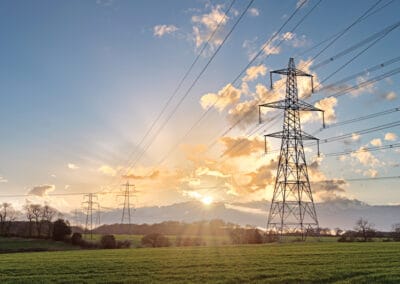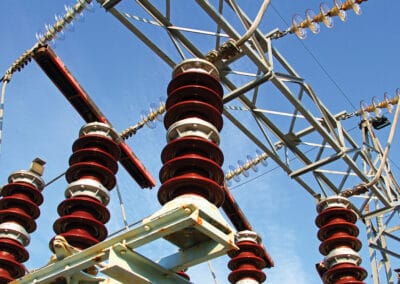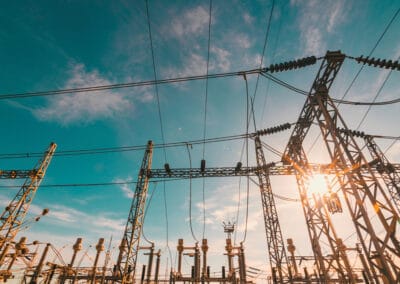HV Earthing System Studies
Ensuring safety and compliance of your electrical asset
Our extensive experience in the assessment, design, modeling and analysis of HV earthing systems ensures that our team of specialists demonstrates compliance with the UK, National Grid, DNO, or international standards for a range of installations such as generation, transmission, distribution or industrial, operating at voltages between 11kV and 400kV.

Soil resistivity measurements and analysis
Preparation of HV earthing system design drawings
HV earthing system modeling and analysis utilizing SES CDEGS software
Earth Potential Rise (EPR) assessment
Calculation of touch, step and transfer voltages
Post-construction Fall of Potential (FOP) resistance measurement and analysis
Third-party design audits
HV earthing system feasibility studies
Impressed voltage studies
Why Us for HV Earthing System Studies?
Our experience
Enoch Hill 33kV Onshore Wind Farm
- PSC were requested to undertake an HV earthing design study for the Enoch Hill 33kV onshore wind farm, in accordance with UK standards. As part of the study, soil resistivity measurements were analyzed to develop soil model for each turbine, the substation and overall wind farm. An earthing system design was produced for each turbine to achieve a resistance of less than 10Ω (where practicable) in accordance with BS EN61400-24. An overall earthing system design was produced for the wind farm and CDEGS earth fault simulation studies were carried out to determine the resistance of the proposed earthing system, the resultant EPR and, touch and step voltages at the site and to confirm the ITU (Hot / Cold) site classification. Read more>
Nairn Road Substation
- PSC were requested to undertake an HV earthing design study for the Nairn Road Substation, in accordance with UK standards. As part of the study, soil resistivity measurements were analyzed prior to designing the buried earth electrode system for the substation. CDEGS earth fault simulation studies were carried out to determine the resistance of the proposed earthing system and the resultant EPR and, touch and step voltages at the site.
South Redhouse BESS
- PSC were requested to update the existing South Redhouse BESS earthing system to accommodate the inclusion of new HV plant, in accordance with ENA TS 41-24, BS EN 50522 and ENA ER S34. As part of the study, an earthing system design for the new HV plant area was incorporated into the existing CDEGS model for the substation and was simulated under single phase-to-earth fault conditions. The resultant EPR and touch and step voltages were determined to confirm site classification in accordance with ITU specifications and the safety of personnel within the site.
Killala (Lisglannon) 38kV Substation
- PSC were appointed to undertake an HV earthing design study for the 38kV AIS substation and associated wind turbines, in accordance with IEEE80, IEEE81 and ESBN specifications 18134 and 18133. As part of the study, soil resistivity measurements were analyzed prior to designing the buried earth electrode system for the substation and each wind turbine. CDEGS earth fault simulation studies were carried out to determine the resistance of the proposed earthing system and the resultant EPR, hot zone contours, and touch and step voltages at the substation and connected wind farm.
Millvale Solar PV Site
- PSC were commissioned to design the Medium Voltage (MV) earthing system for the proposed Millvale Solar PV plant. The purpose of the study was to demonstrate that the earthing system will provide safe step and touch potentials throughout the site in accordance EN 50522. As part of the study, soil resistivity measurements were conducted and analyzed prior to designing the buried earth electrode system for the substation. CDEGS earth fault simulation studies were carried out to determine the resistance of the proposed earthing system and the resultant EPR and, touch and step voltages at the site.
Latest News

HV earthing design studies in urban areas
Join PSC UK consultants Rob Knott and Stephen Lilley as they outline the various challenges of earthing system design for 11kV high voltage (HV) in urban areas and actions to ensure a safe system and work area. read more

The importance of impressed voltages
PSC UK’s Rob Knott and Stephen Lilley explain impressed voltages and how they can be a significant safety hazard to be managed and controlled on any electrical construction site. read more

HV earthing design and analysis in the UK
PSC UK’s Rob Knott and Stephen Lilley explain High Voltage (HV) earthing system analysis & design and why such systems are important to creating safe work areas. read more
Contact us

Robert Knott – Principal Engineer
Rob is an IET Chartered Engineer, with over 15 years of international experience in the design and analysis of HV earthing systems at generation, transmission, distribution and industrial installations. Rob has a comprehensive understanding and practice of UK and international standards such as ENA TS 41-24, IEEE80, IEC 50522; applying this knowledge to HV earthing system studies using the industry-leading earthing analysis software SES CDEGS.

Stephen Lilley – Senior Engineer
Stephen is a senior engineer with over 6 years of experience of HV earthing system assessment and design for generation, transmission, distribution systems within the UK. Stephen has a vast knowledge of the earthing analysis software CDEGS and using UK and international standards such as ENA TS 41-24, IEC 50522 & EREC S41. Furthermore, Stephen has supported UK Distribution Network Operators (DNO) to update and manage their internal earthing policies and has also created various tools to help standardize their distribution substation earthing design process.
